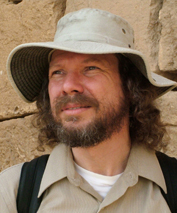





In many ways I straddle a couple of different communities – indeed, different worlds. I am a trained and “card-carrying” academic. I earned a Ph.D. in geology and geophysics at Yale University and I am currently a fulltime tenured faculty member at Boston University. Yet I take a deep and serious interest in various topics that the majority of my fellow academics find, to put it mildly, loathsome. I have challenged mainstream status quo dogma and explored topics that, I have been advised, are best left unexplored if I want to have a successful university career.
My work on ancient cultures, challenging the mainstream view that the origins of civilization do not extend further than five thousand to six thousand years ago, has not endeared me to my more conventional colleagues. Beginning with my re-dating of the core body of the Great Sphinx, which sits on the edge of the Sahara Desert and shows evidence of water weathering and erosion despite the hyper-arid climate of the region during the last five millennia, I have argued that there was an earlier cycle of civilization that well preceded – by thousands of years – the dynastic Egyptians. Since my original work on the Great Sphinx, the discovery and excavation of the tremendously sophisticated megalithic site of Göbekli Tepe in southeastern Turkey, the oldest portions of which date back to the end of the last ice age, confirm that advanced civilization existed thousands of years prior to the period when conventional wisdom asserts civilization began (for further discussion, refer to my book Forgotten Civilization: The Role of Solar Outbursts in Our Past and Future, 2012).
Geologically, based on detailed ice core analyses and other data, the last ice age ended suddenly and dramatically circa 9700 BCE. For decades the cause of the sudden warming remained a mystery, but piecing together multiple lines of evidence, my conclusion is that there was a major solar outburst at this time. Our star, our Sun, spewed forth mighty solar flares, coronal mass ejections (CMEs), and related phenomena that literally scorched parts of our planet’s surface, set wildfires, melted high latitude glaciers suddenly, and ultimately snapped us out of the last ice age. The release of pressure on Earth’s crust due to melting glaciers initiated earthquake and volcanic activity. And as glaciers melted and water evaporated, the atmosphere became overloaded with moisture that came down again as torrential rains, causing widespread flooding and erosion (such as the erosion seen on the core body of the Great Sphinx). The magnetosphere, ionosphere, and ozone layer were probably compromised, allowing dangerous levels of radiation to penetrate to the surface of Earth. The best way to escape was to go underground – and indeed there is evidence that pockets of human survivors did just this, as witnessed by natural caves and artificial underground shelters utilized during this period and subsequently; the Cappadocia area of Turkey is a prime example, with its rock-cut houses and underground cities that could shelter thousands of people along with their animals and food supplies. Likewise, there were major extinctions of large animals at the end of the last ice age, animals who could not easily escape the surface devastation.
Advanced civilizations had developed by the end of the last ice age, but this earlier cycle of civilization came to an end with the solar outburst catastrophe of circa 9700 BCE. A “solar-induced dark age” (SIDA) ensued, one that lasted some six thousand years, until civilization re-emerged in Egypt, Anatolia, Mesopotamia, and elsewhere.
Interestingly, the story of Atlantis as recounted by Plato places the fall of that mighty civilization at circa 9600 BCE, in close correspondence to the modern dating of the end of the last ice age. Furthermore, Plato’s descriptions of the catastrophes that brought the Atlantean civilization to a close sound very much like the results that could ensue from a major solar outburst. When I point out such correspondences to my academic colleagues, I generally get either smirks or downright outrage. After all, according to the mainstream view, the Atlantis legend is just that, a legend or myth – perhaps a political (or even musical, according to some) metaphor with no basis in reality when it comes to chronology and genuine events in the physical world. My conventional colleagues assure me that the civilization of Atlantis never actually existed. Successful and accomplished university professors do not go hunting for Atlantis or even discuss the topic other than in the context of literature or philosophy.
Another realm I have explored, and which has piqued rather than endeared me to my academic colleagues, is what might be loosely termed the “spirit world”. I have long had a serious interest in psychical research, the paranormal, and subject matter that is generally termed more technically parapsychology. My interest arises in large part from my studies of ancient civilizations, for ancient peoples consistently included psychic and parapsychological phenomena among their core belief systems. And, whether we care to acknowledge it or not, humanity in today’s world of modern technology is still shaped and influenced by our cultural inheritance from remote ancient times.
One aspect of this very ancient inheritance is a set of beliefs and practices that in modern times has been broadly termed “shamanism”. I have to admit that I cringe a bit when I read or hear the term “shamanism” as in my assessment it has been overused and even abused during the past few decades, becoming a catch-all phrase, but perhaps at this point there is no better replacement term. Modern classical shamans and their belief systems are centered in the region of Siberia (see for instance the masterful 1935 study by S. M. Shirokogoroff with the evocative title Psychomental Complex of the Tungus [reprinted 1999]) and in its present form Siberian shamanism may be only a few centuries old, but the antecedents of shamanic beliefs go back to well before the end of the last ice age.
The core of shamanism is the belief in, and acknowledgment of, spirits and the spirit world. A shaman is a person who has become “a master of spirits, at least of a group of spirits” (Shirokogoroff, p. 271; italics in the original). According to shamanic beliefs, the cosmos is inhabited by spirits who can at times interact with and affect humans. There is a world of spirits, a world that exists simultaneously with the ordinary physical and material world we all take for granted. A human, such as a shaman, can interact with and visit the spirit world. Such fundamental shamanic beliefs can be traced back tens of thousands of years, and were common to the ancestors of all living humans (see E. J. Michael Witzel’s insightful 2012 tome, The Origins of the World’s Mythologies).
Well, it is fine and good from a conventional academic perspective to study primitive belief systems, such as those of shamanism, but one must never take such superstitious nonsense seriously – that would certainly be crossing the proverbial line at the risk of exile to the academic equivalent of Siberia. But there was in recent times a well-known and distinguished anthropologist who had crossed this line: Edith Turner (1921 – 2016; she was in the Department of Anthropology at the University of Virginia, Charlottesville, at the time of her death). In various publications Turner testified that during a traditional curative ritual in Zambia she witnessed a spirit form. As she described it, “the traditional doctor bent down amid the singing and drumming to extract the harmful spirit” . . . “I saw with my own eyes a large, gray blob of something like plasma emerge from the sick woman's back” (E. Turner, “The Reality of Spirits”, published in the journal Shamanism, volume 10, number 1, Spring/Summer 1997). This, I dare suggest, is hardly an isolated incident. Many people have had similar experiences, but such persons and their testimonies are simply dismissed by traditional academics who consider it all a matter of delusions, self-delusions, or downright fraud. The average anthropologist may record such stories told by informants, but certainly not take them as literal recountings of what really happened.
If there is such a thing as the serious academic study of spirit phenomena, then it would fall under the realm of parapsychology (which also goes by the older name of psychical research). Here what I mean by “serious academic study” is not the study of such phenomena as primitive nonsensical superstitious beliefs that might simply serve the function of bonding a society together or relieving social stress, but rather considering “spirit phenomena” objectively (if indeed such is possible – one can try to do one’s best) and ask whether or not such phenomena are genuine, and if they are, what might be the underlying causative factors. Are the spirits real? Is there a true spirit world?
Perhaps needless to say, parapsychology is itself generally considered a fringe discipline by other academics and is often dismissed out of hand. Yet over a century of serious scholarly studies of telepathy, clairvoyance, precognition, unconventional medical cures, “ghost sightings”, poltergeist occurrences, psychokinesis/telekinesis, and so forth, have demonstrated that these types of phenomena genuinely occur, although granted there are also numerous cases of fraud and charlatanism (for an introduction to this field, see the 2008 anthology that I co-edited, The Parapsychology Revolution; see also Chapter 14 and Appendices 2 and 4 of Forgotten Civilization). These types of phenomena have been traditionally attributed to spirits and a spirit world. Many parapsychologists do not want to hypothesize spirits to explain the strange phenomena they study. Instead, they may invoke new discoveries or exotic phenomena in other fields, such a quantum entanglement, in an attempt to explain the telepathic transmittal of information or other paranormal incidents. But is this ultimately any more “scientific” than postulating, at least as a working hypothesis, that there might be a spirit world? Indeed, it strikes me that postulating a spirit world is not incompatible with postulating “exotic” physical processes (some of which have not even been discovered) to explain various unconventional parapsychological (paranormal) phenomena.
Maybe a spirit world exists, genuinely exists, in another realm or dimension. This is an idea that is hardly new. Across Siberia there is an often-told story about a person who accidentally visits the spirit world. Through a hole in the ground or some sort of cave, a man (or woman) unknowingly enters into the realm of the spirits, not realizing where he is. Wandering along, he comes upon a camp where there are people gathered. He attempts to interact with these people, but they step on him and bump into him. It becomes evident that they cannot see him. When the man touches any of the people, and in one version of the story when he teases some girls, they become ill. The dogs in the camp bark at the man, apparently sensing his presence. The people suspect that something is wrong, and they hire a shaman to rid them of the “evil spirit” that is plaguing them. The human man slowly comes to understand that he is among spirits, he has entered the spirit world, and from the perspective of the spirits (who consider themselves human), he is considered an evil spirit. The spirit shaman is ultimately successful and drives the human from the spirit world and he returns to the world of humans (a version of this story is recounted by Charles Stépanoff, Inner Asia, volume 11, number 2, 2009, p. 292).
One of the lessons that might be drawn from this story is that, as a group, spirits are neither all good nor all bad – just as not all humans are alike. An “evil spirit” may be nothing more than a spirit “out of place” and interacting, perhaps inadvertently, with the human realm. An accomplished shaman can redirect the misplaced spirit to the world where it belongs. Of course this does not preclude genuinely “good” or “evil” spirits, but it may well be that such appellations are often inappropriate and the majority of spirits never interact with the human realm (or vice versa).
Returning to the question of whether or not spirits might be real, might be genuine, this widespread story leads me to ponder the possibilities. Is it conceivable that there is literally a spirit world, either very different from our world, or perhaps parallel to the world of humans (as depicted in the story from Siberia)? Might a spirit world exist in another dimension or time frame that only occasionally or under peculiar circumstances intersects with, or interacts with, the world with which we are familiar? Could the spirit world be composed of some form of exotic matter that we cannot readily detect, such as the hypothetical dark matter or mirror matter of modern physics?
The concept of mirror matter is something that I find particularly fascinating. To greatly oversimply the concept, our world is composed of particles that are said to be “left-handed” at a fundamental level, and theoretically there could be matter that is “right-handed”. Such right-handed matter, or mirror matter (also known as shadow matter or Alice matter; mirror matter is not to be confused with antimatter) would create a world unto itself that is very similar to, or from a physics point of view, virtually identical to, our own world. That is, mirror matter particles would interact with each other in the same manner that ordinary particles interact with each other. But, very importantly, mirror matter particles and ordinary matter particles would barely interact with one another. A wall composed of mirror matter would not only be invisible to you, but you would be able to walk right through it. If a spirit world were composed of mirror matter, we would not normally be aware of it. (It can be argued that we should be able to detect mirror matter via gravity anomalies, but depending on the density and distribution of mirror matter, such anomalies may either effectively cancel out or be negligible, possibly beyond the reach of the most sensitive equipment currently available.) But perhaps under incredibly unusual circumstances, for we still do not actually know if mirror matter exists – although there is some evidence that it does – or exactly what all of its properties might be, we could just possibly interact with mirror matter organisms. Could a spirit world be composed of mirror matter? Could the interaction of a mirror matter world and our ordinary matter world occasionally give rise to balls of “plasma” (essentially electrically-charged particles) by a process referred to by physicists as “kinetic mixing” of mirror photons and ordinary photons, or some other interaction of mirror and ordinary subatomic particles? Could this be the explanation for the “gray blob” that Edith Turner observed emerging from the sick woman’s back? One might argue that the energies involved to create observable interactions between mirror matter and ordinary matter would be much higher than the energies observed in everyday life, but then again we really do not know, given that we do not have a good handle on the properties of mirror matter vis-à-vis ordinary matter – that is if mirror matter even exists.
Another explanation for spirits, or at least certain types of spirits or ghosts, is that they are composed of collections of hydrogen (the simplest atom) and/or subatomic particles of which hydrogen and all other atoms are composed – an idea that my wife, Catherine Ulissey, first proposed when pondering the ancient Egyptian belief that upon death we are reborn as stars in the sky. If stars are composed largely of hydrogen (hydrogen clouds which collapse into suns due to gravitational forces, as the basic theory of star formation asserts), and if some of the elements in the human body can be traced back to stars (“stardust”), then is it not reasonable to conclude that upon death our hydrogen is released from us and, being light, it floats upward to space eventually completing a grand cycle?
The basic postulate of this hypothesis is that we as living organisms with physical bodies are in large part made of hydrogen. Hydrogen is found in water (H2O), in all of our carbon-hydrogen organic compounds and molecules, and so forth. Information can be encoded in hydrogen and the subatomic particles that make up our hydrogen just as it has been demonstrated experimentally that pure liquid water can encode information (this I discuss in Chapter 14 of Forgotten Civilization). When we physically die, some of our hydrogen (and its constituent subatomic particles) is released. This released hydrogen carries detailed information about us, and furthermore these hydrogen atoms and associated subatomic particles are, to use the jargon of quantum physics, entangled (having been closely associated in life in an organism, in a personality), and thus tend to aggregate, collect, and stay in “communication” or connected together, upon release from the body. Furthermore, when a person dies, various diverse collections of hydrogen carrying different sets of information, may be released from the physical body. If the personality, the consciousness, of a person from this life is to survive in a recognizable form in the next life, it may be important and necessary to combine and re-integrate these “psychic components” in the hereafter. Indeed, the ancient Egyptians had very complex notions of the different aspects of a person – much more sophisticated and detailed than the modern and rather simplistic notions of body, soul, and spirit. And the ancient Egyptians, as well as many other ancient and indigenous peoples, emphasized the necessity of reintegrating the “soul components” when a person passed to the other side. Modern science may once again demonstrate the truth of the insights of ancient traditions.
But here, once again, I am treading on dangerous ground – at least when it comes to academic respectability. To even discuss such matters raises suspicions amongst many of my conventional academic colleagues. It is taboo. But what about the global belief in spirits, a belief that can be traced back tens of thousands of years? All nonsense? Or, as the cliché goes, where there is smoke there is fire; is there some underlying basis for the acceptance of the spirit world? And then we have the direct testimony of Edith Turner. Perhaps the spirits do exist, but as we have accelerated our technological developments we have also pushed the spirit world ever more into the background. Then again, perhaps ultimately technology will fully reveal the realm of the spirits to us. I am not sure what to think, but it definitely makes me think.

Dr. Robert M. Schoch, a full-time faculty member at Boston University since 1984, earned his Ph.D. (1983) in Geology and Geophysics at Yale University. In the early 1990s, Dr. Schoch’s geological analyses of the Great Sphinx demonstrated that the statue is thousands of years older than the conventional dating of 2500 BCE, bringing him international fame and recognition. His assertions that there was an earlier cycle of civilization before civilization is supposed to have existed, though attacked by many members of the Egyptological and archaeological establishments, have stood the test of time. Stunning confirmation of Dr. Schoch’s views has come with the discovery of the highly sophisticated 12,000-year-old site of Göbekli Tepe in southeastern Turkey. In recent years, further data and re-analysis of his previous work has led Dr. Schoch to conclude that the origins of the Sphinx go back millennia further than he first proposed. Dr. Schoch is the author of numerous books and articles, both academic and popular, including Forgotten Civilization: The Role of Solar Outbursts in Our Past and Future (Inner Traditions, 2012). He has reached audiences around the world via television, radio, live presentations, and the Internet (the Emmy-winning documentary The Mystery of the Sphinx, which first aired on NBC, remains a favorite among audiences). In recognition of his scientific contributions to the study of ancient civilizations, in 2014 Dr. Schoch was awarded the title of Honorary Professor of the Nikola Vaptsarov Naval Academy in Varna, Bulgaria.
Dr. Schoch is a co-founder of the non-profit ORACUL (Organization for the Research of Ancient Cultures). ORACUL’s website: www.oraculonline.org
Dr. Schoch’s website: www.robertschoch.com
